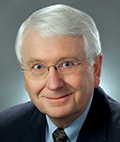From APSF Educational Videos to Your Practice: How to Make it Happen
Saturday, 1-3 p.m.
Upper Level 20D

Robert K. Stoelting, M.D.
Every physician anesthesiologist should know which patients are at elevated risk for fire hazards — surgery above T5 and the use of an ignition source in proximity to an oxidizer-enriched atmosphere. Yet despite the knowledge, surgical fires are a continuing hazard to patients, to health care providers and to facilities.
“Fire safety is not only an old issue — it is nearly always preventable,” said Robert K. Stoelting, M.D., President of the Anesthesia Patient Safety Foundation (APSF). “Prevention requires anesthesiologists to perhaps change their practice in how and when they deliver oxygen. It is an epidemic that is preventable if you follow known safety precautions.”
Dr. Stoelting is the moderator for the workshop “From APSF Educational Videos to Your Practice: How to Make it Happen,” from 1 to 3 p.m. today in Upper Level 20D. The session will focus on practical strategies to reduce two of anesthesia’s most devastating complications — surgical fires and postoperative visual loss.
Don’t expect the standard lecture format, he said. Presenters will offer informational background material, but the bulk of the session will be devoted to small-group breakouts to discuss implementation strategies that do and don’t work.
Preventing fires takes very little effort, Dr. Stoelting noted. The root cause of most surgical fires is the use of supplemental oxygen via an open delivery system. The open delivery system creates an oxygen-enriched environment that needs only an ignition source to spark a fire. APSF even has a free video presentation on its website. The group has received more than 8,000 requests for copies to use for O.R. staff training.
“We have been taught from the first day of our training to give oxygen,” Dr. Stoelting said. “That is tough to break, even knowing the reality that oxygen is just one of the drugs we use. Oxygen does not have to be given to every patient. Instead of giving oxygen automatically, we advocate that you monitor every patient. Only if they need oxygen should they get oxygen. And if more than 30-percent oxygen is needed, it should be given using a closed system that does not enrich the local atmosphere to create fire potential.”
Post-surgical blindness is a more difficult issue. Evolving data from the ASA Postoperative Visual Loss (POVL) Registry has a profile of patients at risk for vision loss and steps that can be taken in surgical and anesthetic management that might decrease this devastating complication.
But not every surgeon or anesthesiologist is comfortable discussing the risk of POVL with patients. And not every informed consent for surgery includes the very real risks of POVL in selected patients.
“We are seeing significant pushback to the inclusion of POVL in informed consent,” Dr. Stoelting said. “Discussing the potential for blindness won’t prevent the injury, but it is a way to confirm that the clinician taking care of them is aware of the risk as well as the current recommendations and best practices for preventing blindness.”
Return to Archive Index
